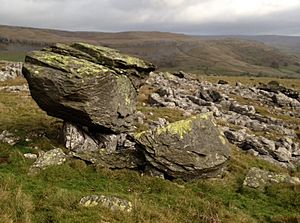Norber erratics facts for kids
The Norber erratics are an amazing group of giant rocks found in the Yorkshire Dales in Britain. These rocks are called "erratics" because they don't belong to the area where they are found. They were carried there by ancient ice sheets! You can find them on the southern slopes of Ingleborough, near the village of Austwick.
These erratics are a perfect example of how glaciers shaped the land in northern England. They show us how powerful ice can be in moving huge rocks and changing landscapes over thousands of years.
Contents
What Are Norber Erratic Boulders?
The Norber erratics are huge rocks that were moved by glaciers. They are made of a dark rock called greywacke, which is a type of sandstone. This rock is much older than the limestone found in the Yorkshire Dales.
How Did They Get Here?
About 12,000 years ago, at the end of the last Ice Age, huge sheets of ice covered much of Britain. As these glaciers moved, they picked up rocks of all sizes, including these massive greywacke boulders. When the climate warmed and the ice sheets melted, they dropped these rocks in new places. That's how the Norber erratics ended up on the limestone hills of the Yorkshire Dales.
The Mystery of the Pedestals
Many of the Norber erratics sit on tall "pedestals" of limestone, almost like they are on little tables. These pedestals can be up to 30 centimeters (about 12 inches) high. This is a very special feature!
How Pedestals Formed
The pedestals formed because the erratic boulders protected the limestone underneath them. The surrounding limestone pavement slowly wore away over thousands of years due to rain and weathering. Rainwater is slightly acidic, and it slowly dissolves limestone. But the big greywacke boulders acted like umbrellas, shielding the limestone directly beneath them from the rain. This meant the limestone under the boulders dissolved much slower than the limestone around them, creating the pedestals we see today.
Scientists have studied these pedestals to estimate how fast the surrounding limestone has worn away. They believe the limestone pavement has lowered by about 25 millimeters (about one inch) every 1,000 years.
How Old Are the Erratic Boulders?
Scientists use a method called cosmogenic dating to figure out how long rocks have been exposed to the sky. This method looks at tiny changes in the rock caused by cosmic rays from space. Using this technique, scientists have found that the Norber erratics have been exposed on the surface for about 17,900 years. This shows just how long these amazing rocks have been sitting there, telling a story of ancient ice ages!


